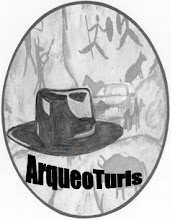


 O conjunto arqueológico da Tourega, é composto pelas termas da Villa romana, datada do séc. III d.C. Está situada no território da antiga sede municipal, Ebora Liberalitas Iulia, gozava de uma localização privilegiada; se por um lado se situa à beira da estrada que ligava Ebora a Salacia, por outro, distava apenas 5 km da estrada Ebora-Pax Iulia, o que por seu lado atesta que seria uma propriedade de exploração agrícola, produzindo intensivamente visando o comércio. A escavação do edifício principal pôs a descoberto três fases diferentes de construção. Na primeira fase, situada a norte, pode-se observar apenas um hipocausto e a respectiva fornalha. A segunda fase de construção (finais do séc. III d.C. ou princípio do IV d.C.), mostra dois conjuntos independentes de termas, ou seja, termas duplas. O problema consiste em saber a quem eram destinados. Um destinado aos homens e outro às mulheres? Ou um pertencente à família do proprietário e o outro aos seus dependentes? Novas salas e tanques foram construídas a oeste e a sul durante o séc. IV d.C. Este período corresponde à 3ª fase. Os trabalhos de conservação proporcionam uma visita agradável.
O conjunto arqueológico da Tourega, é composto pelas termas da Villa romana, datada do séc. III d.C. Está situada no território da antiga sede municipal, Ebora Liberalitas Iulia, gozava de uma localização privilegiada; se por um lado se situa à beira da estrada que ligava Ebora a Salacia, por outro, distava apenas 5 km da estrada Ebora-Pax Iulia, o que por seu lado atesta que seria uma propriedade de exploração agrícola, produzindo intensivamente visando o comércio. A escavação do edifício principal pôs a descoberto três fases diferentes de construção. Na primeira fase, situada a norte, pode-se observar apenas um hipocausto e a respectiva fornalha. A segunda fase de construção (finais do séc. III d.C. ou princípio do IV d.C.), mostra dois conjuntos independentes de termas, ou seja, termas duplas. O problema consiste em saber a quem eram destinados. Um destinado aos homens e outro às mulheres? Ou um pertencente à família do proprietário e o outro aos seus dependentes? Novas salas e tanques foram construídas a oeste e a sul durante o séc. IV d.C. Este período corresponde à 3ª fase. Os trabalhos de conservação proporcionam uma visita agradável.Estes trabalhos contribuíram para restaurar o valor que Tourega tivera outrora.
----------
The archaeological set Tourega, is composed by the Roman Villa thermae, dated century III AD. Located in the territory of the old municipal headquarters, Ebora Liberalitas Iulia, enjoyed a privileged location; if on one hand it was placed near the road that linked Ebora to Salacia, the other hand, was only 5 km from the road Ebora-Pax Iulia, which in turn certifies that was a property of agricultural exploitation, producing intensively aiming the market.
The excavation of the main building has discovered three different stages of construction. In the first phase, located to the north, you can see only one hipocausto and the the respective furnace.
The second phase of construction (end of the century III AD or the beginning of IV AD), shows two sets of independent thermae, or double thermae. The problem is to know whom they were intended. One for men and another for women? Or one belonging to the family of the owner and the other to their dependents? New rooms and tanks were built to the west and south during the century IV AD. This period corresponds to Phase 3. The work of conservation provide a pleasant visit.
This work helped to restore the value that had once Tourega.
The excavation of the main building has discovered three different stages of construction. In the first phase, located to the north, you can see only one hipocausto and the the respective furnace.
The second phase of construction (end of the century III AD or the beginning of IV AD), shows two sets of independent thermae, or double thermae. The problem is to know whom they were intended. One for men and another for women? Or one belonging to the family of the owner and the other to their dependents? New rooms and tanks were built to the west and south during the century IV AD. This period corresponds to Phase 3. The work of conservation provide a pleasant visit.
This work helped to restore the value that had once Tourega.
Fontes: Diversas
.








Sem comentários:
Enviar um comentário